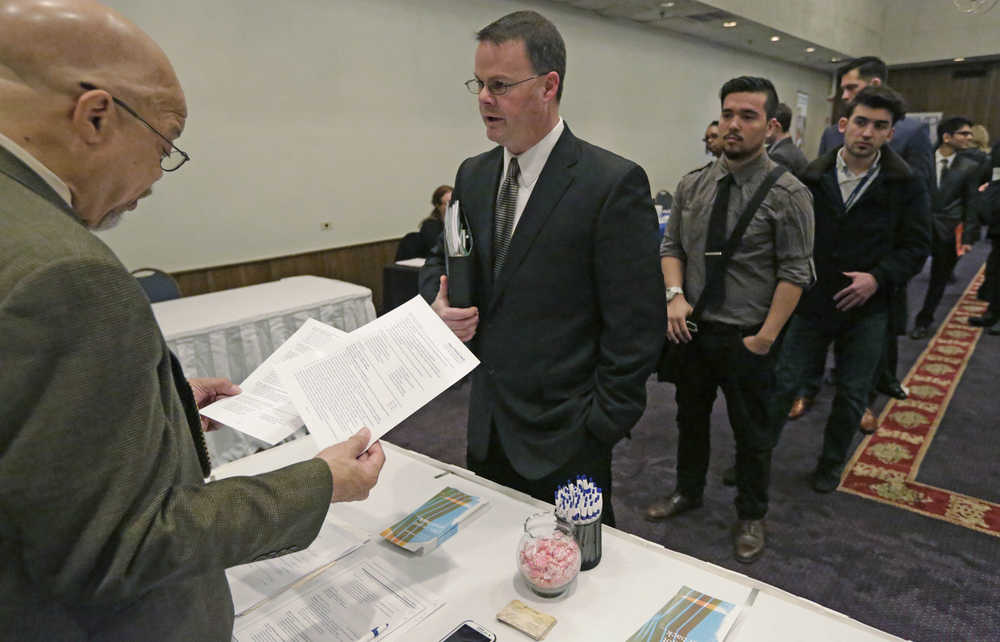WASHINGTON — U.S. employers shrugged off signs of weak growth and extended their long stretch of steady hiring in March, adding 215,000 jobs.
The unemployment rate ticked up — to 5 percent from 4.9 percent in February — but mostly for a good reason: More Americans came off the sidelines to look for work, though not all found jobs.
That is the fifth time in the past six months that the proportion of Americans working or looking for work has increased, an encouraging trend after that figure fell to four-decade lows last year. Many Americans, discouraged by a lack of available jobs, had given on their job hunts since the recession, while others stayed home to take care of family members. Many baby boomers have also been retiring.
“This is a vote of confidence on the part of workers regarding the health of the U.S. economy,” said Nariman Behravesh, chief economist at IHS.
The data suggests that employers remain confident enough in their business prospects to add staff, even as overall growth has slowed since last winter. Many analysts estimate that the economy grew at a 1 percent annual rate or below in the first quarter. Continuing job gains indicate that employers may see the slowdown as temporary.
The proportion of Americans with jobs rose to 59.9 percent, the fifth straight increase and highest level since March 2009 during the depths of the Great Recession. Still, that figure remains far below its pre-recession level of 62.7 percent.
Kevin Wilson, CEO of Buzz Franchise Brands, says the growing economy is helping him expand. He plans to add eight more employees to his headquarters staff of 22 by the end of this year.
The company operates Mosquito Joe, a pest-control provider, and Pool Scouts, which provides pool-cleaning services. Wilson expects to hire more workers at the existing 113 Mosquito Joe franchises and open 58 new ones. Those steps should create about 450 new jobs.
Wilson said both franchises are benefiting from retirements by wealthier baby boomers.
“With this aging population, a lot of these home services they are going to want to find people to do it for them,” he said.
Investors were initially unimpressed by the jobs figures, but stocks picked up in mid-day trading. The Dow Jones industrial average increased 27 points to 17,712.
Steady hiring is also contributing to somewhat higher pay. Average hourly wages rose 2.3 percent from a year earlier to $25.43. Annual wage gains have improved since the early years of the recovery, but they are below a peak of 2.6 percent reached in December.
Sluggish wage growth has been a weak spot in the economy and a source of frustration for many workers since the Great Recession ended in 2009. Paychecks typically grow at a 3.5 percent pace in a strong economy.
That frustration has spilled over into widespread demands for a higher minimum wage. California approved a measure this week to lift its minimum to $15 an hour by 2020, more than double the current federal minimum of $7.25. New York lawmakers have also approved a $15 minimum that will phase in over many years.
Heavy hiring by low-wage employers is likely one driver behind the demands for greater pay. Retailers added 47,700 jobs last month and have created 358,000 in the past year. Hotels and restaurants gained 26,000 jobs in March.
That hiring has been offset by some higher-paying positions, including in construction, financial services, and professional and business services, which include engineers, accountants and architects.
Manufacturing, hit by slower growth overseas, posted another month of job losses. Mining, which includes the oil and gas drilling sector, also cut jobs. Low oil prices have cost the industry 185,000 jobs since September 2014.
With more Americans flooding into the work force, employers likely have more people to choose from when filling jobs. That takes the pressure of them to offer sharply higher wages.
Greater hiring can help fuel consumer spending, which is a critical source of growth this year. Other potential drivers of the economy, such as exports and business investment, have weakened.
Yet consumer spending has faltered since last winter after healthy gains in 2015. Spending ticked up just 0.1 percent in February for the third month in a row. That tepid trend caused many economists to slash their growth estimates for the first quarter.
Other economic data has been mixed.
Several reports suggest that manufacturers may be stabilizing after a difficult 2015, when weak overseas growth and the strong dollar hurt production.
Meanwhile, Americans have pulled back a bit from home-buying. Sales of existing homes fell a sharp 7.1 percent in February, held back by a lack of available supply that has pushed up prices.

